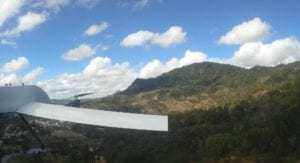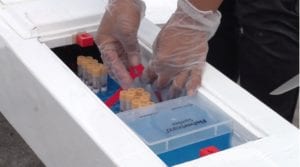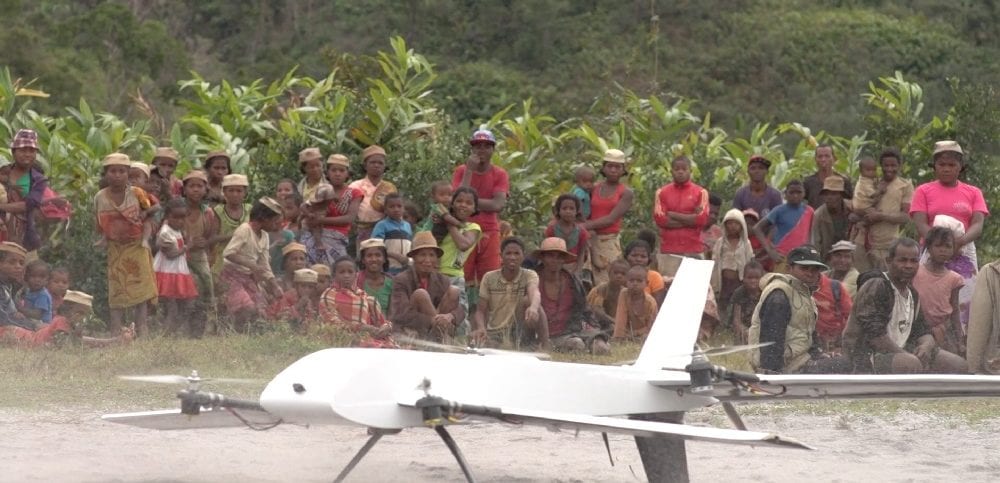By Daniel Dunaief
Stony Brook University is taking to the skies to help people on the ground in Madagascar. Through its Global Health Institute, SBU plans to bring drones to the island nation off the southwest coast of Africa that will carry medical samples from hard-to-reach villages to its state-of-the-art research facility, Centre ValBio.
Late last month, Peter Small, the founding director at GHI, brought a drone to Madagascar, where it flew from the research station to a nearby village. The drones can fly like an airplane over 40 miles of terrain, while they take off and land like a helicopter, enabling a smooth ride to protect the samples inside the cargo area.
“Our challenge is to align the most pressing challenges that are amenable to supply chain and specimen transport and intervention,” Small said. Madagascar is dealing with “high rates of tuberculosis” among other health challenges, he said, adding that a university like Stony Brook can take complicated problems and find solutions in the real world.
The drones can provide two important functions for Madagascar: monitoring the outbreak of any unknown and potentially dangerous disease and offering health care for people who live in areas that are inaccessible by road, Small said.

“Diseases like Ebola and Zika frequently pop up in remote areas,” said Small, a medical doctor who worked at the Bill & Melinda Gates Foundation prior to joining Stony Brook University in 2015. Having sites where drones can land and collect specimens will allow village health workers to send off specimens for analysis, providing greater clarity on the incidence of specific diseases throughout the country.
Additionally, people in remote areas can send samples back to a lab to test for medical conditions, such as tuberculosis. After medical technicians run tests, the drones can return not only with drugs that can treat the condition but also with instructions on how to treat patients.
The drones can carry a special box to record whether a pill bottle is opened. The box also can carry a sound recorder that can recognize and count coughs, Small said. When the drone returns with another supply of medication, the previous medicine can make the return trip to the lab, where doctors can determine whether the cough is getting better and can see how much medicine the patient took.

Ideally, the drones will not require any specialized knowledge to fly. Once people in rural villages have a signal, they can request a drone, which can transport samples to a lab or bring medicine back to the village.
“We want to put these drones in the hands of the village health workers and the local health system,” said Small. He said those working with this project hoped people in the village would welcome this medical service but were unsure how it would be received. “We had no idea how people would respond to these” drones, Small said. The initial run, however, was successful. GHI plans to bring two more drones to Madagascar in the next few months.
A company in Michigan called Vayu manufactures the drones, which weigh 35 pounds, are about the size of a picnic table and can carry up to a 5-pound payload, said Daniel Pepper, the company’s chief executive officer. Using an electric, rechargeable battery, the drones can travel up to 40 miles. In the near future, Pepper hopes to increase that distance to as many as 65 miles.
Vayu has manufactured dozens of these drones. The recent Madagascar test was the first time they had used the unit in an international setting. Pepper is “speaking to partners and potential customers in over a dozen countries,” including the United States, where drones might offer a connection between medical centers in urban areas and harder-to-reach rural communities.
Pepper said the drone was the only one on the market that’s electric powered and can carry this payload over this range. “It takes off automatically and lands vertically,” he said and described the landing as “soft.”
According to Small, Madagascar could benefit from these drones, particularly in diagnosing the myriad health challenges of the area. “Madagascar is a remarkable area to start addressing some of these problems and bringing innovation,” he said.
In some villages, as many as 90 percent of people have intestinal parasites, which contributes to malnutrition and stunts growth, Small said. Small and Patricia Wright, the founder and executive director of Centre ValBio who has been working in the area for 30 years, are hoping to broaden and deepen the connection between Stony Brook and Madagascar.
The dental school has coordinated dental missions to treat hundreds of patients a day. Small said the dean of the dental school, Mary Truhlar, recently visited Madagascar to go beyond medical missions to “engage in improving the quality and training, care and health system issues.”
Small is excited with the way computational science and high-end mathematics are coming in to describe the complexities of health problems to the government of Madagascar. This will assist the government in generating medical priorities. Small has set some large goals for his role: “If life is not palpably better in five, 10 or 15 years” in Madagascar, “I will have failed at my job.”






